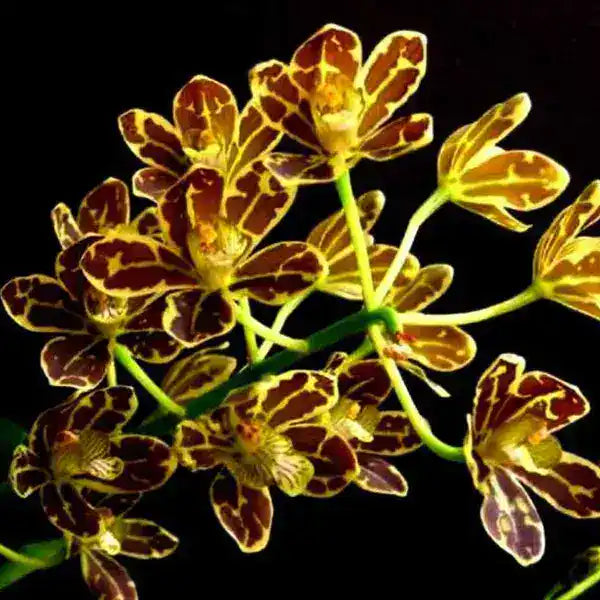
Grammatophyllum Scriptum Blooming stage
Selling Size : Last Image | Net Pot Included | Secure Packing
Grammatophyllum scriptum, often called the "Written Grammatophyllum" or "Leopard Orchid" due to its distinctive markings, is a spectacular species known for its impressive size and prolific blooms. To encourage consistent and abundant flowering, focus on providing optimal growing conditions throughout the year.
Here's a breakdown of blooming care specifically for Grammatophyllum scriptum:
1. Light - The Key to Blooms:
Bright, indirect light is paramount for flowering. This is arguably the most crucial factor for Grammatophyllum scriptum to bloom. They need significant light, similar to Cattleya or Dendrobium orchids.
Morning sun is ideal: An east-facing window that provides several hours of direct morning sun is excellent.
Filtered light: If grown in a south-facing window or outdoors, ensure light shading (e.g., a sheer curtain indoors, or under a canopy of trees outdoors) from late morning to late afternoon to prevent leaf scorch. While they love bright light, intense, direct midday sun can burn the leaves.
Optimal leaf color: Healthy leaves that are a lime-green color with a slight yellowish tint indicate sufficient light for flowering. Dark green leaves often mean insufficient light.
2. Temperature for Flower Initiation:
Warm temperatures are essential:
Daytime: Maintain temperatures between 22−30∘C (72−85∘F).
Nighttime drop: A crucial element for flower initiation is a distinct temperature drop at night, ideally around 6∘C (10∘F). Aim for nighttime temperatures of 18−24∘C (65−75∘F). This cool down helps trigger the development of flower buds.
Grammatophyllum scriptum can tolerate considerable summer heat, but ensure increased air circulation and humidity to prevent stress.
Protect from frost, especially when flower spikes are forming or the plant is in bloom.
3. Watering and Resting Period:
Heavy watering during active growth and spiking: During the main growing season (typically March to October in the Northern Hemisphere, adjust for your local climate in India), and especially when flower spikes are emerging, water frequently and heavily. The roots should get thoroughly wet but dry out relatively quickly.
Slightly drier in winter/resting period: While Grammatophyllum scriptum doesn't have a harsh dry dormancy, it benefits from slightly reduced watering during cooler, less active months (late fall to early spring). The pseudobulbs should remain plump, only slightly shriveled. If they shrivel significantly, increase watering.
Triggering blooms with a dry period (optional but effective): Some growers find that a short, more pronounced dry period can encourage blooming. This involves reducing irrigation for about 1-2 weeks (if you normally water daily, water once every 1-2 days). During this time, only water the roots, not the leaves. Following this dry period, you can introduce a high-phosphorus fertilizer to further stimulate flowering.
4. Fertilization for Flowering:
Regular feeding is vital: During the active growing season (when new growths are emerging and maturing, and especially as flower spikes begin to develop), fertilize consistently.
Balanced fertilizer: A balanced NPK fertilizer (e.g., 20-20-20 or 15-15-15) at half strength, applied with almost every watering, is a common practice for bark mixes. Always flush with clear water once a month to prevent salt buildup.
High-phosphorus fertilizer for bloom initiation: Once new pseudobulbs have matured or after a short dry period, switch to a high-phosphorus fertilizer (e.g., 0-52-34 or 10-55-10 NPK) for 3-4 consecutive weeks. This helps to shift the plant's energy towards flower production. Ensure the plant is watered thoroughly before applying fertilizer to prevent root burn.
Grammatophyllum are known to respond well to organic fertilizers like fish emulsion or manure teas.
5. Humidity and Air Circulation:
High humidity (45-60% or even 50-70%): Maintain good humidity, as this helps support healthy growth and flowering. Use a humidity tray or humidifier if your environment is too dry.
Excellent air circulation is non-negotiable: In high humidity, strong airflow is absolutely essential to prevent fungal and bacterial issues, especially on the large leaves and developing flower spikes.
6. Potting and Root System:
Coarse, well-draining medium: Use a medium to large grade orchid bark mix, sphagnum moss, or a blend of charcoal and coconut fiber. Good drainage is key.
Large pots/baskets: Grammatophyllum scriptum are massive plants with extensive root systems. They often do best in large pots or, even better, in sturdy wooden or wire baskets, which provide excellent aeration for their unique dual root system (downward-growing normal roots and upward-growing "catch" roots).
Repotting: Repot every 1-2 years, ideally in spring, when new growth begins or after flowering. Choose a pot that allows for at least 1-2 years of growth, as frequent repotting into significantly larger pots can sometimes cause the plant to put energy into vegetative growth instead of flowering.
7. Patience and Maturity:
Grammatophyllum scriptum typically needs to be a mature plant with numerous well-developed pseudobulbs to bloom reliably. Don't be discouraged if a younger plant doesn't flower immediately. With consistent care, it will eventually reach blooming size.
The flower spikes can be very long (2-3 feet tall) and bear a remarkable number of flowers (50-100), lasting for 1-2 months, usually in summer to fall.
By focusing on these specific needs, particularly adequate light, the night temperature drop, and appropriate fertilization, you can significantly increase your chances of enjoying the magnificent blooms of your Grammatophyllum scriptum.
Sources

